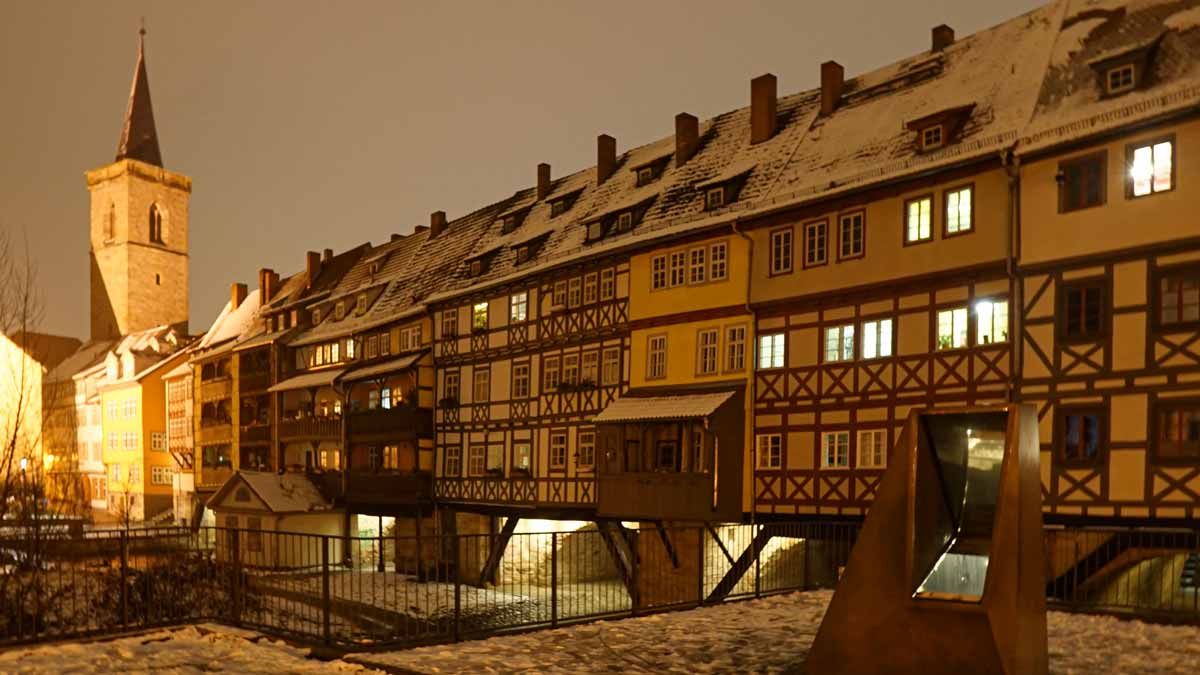Krämerbrücke FAQ
Nine things you absolutely need to know about the Krämerbrücke
Which river does the Krämerbrücke cross?
The Krämerbrücke spans the Gera, still called Erphes in the Middle Ages. This 85 kilometer long river rises with two main sources in the ridge area of the Thuringian Forest around the Schneekopf. Rivers were always a horror for traders in past centuries. Back then they were nowhere near as regulated as they are today and were therefore, firstly, a source of danger and secondly, an obstacle to traffic. The construction of bridges was therefore essential to the survival of a successful trading city.
Since when has the Krämerbrücke existed in Erfurt?
We don't know exactly when the first bridge structure was built. A document from 1175 mentioned a wooden bridge over the Gera for the first time, but in connection with a devastating fire.
Previously, passage in the city area was only possible through a ford. The place name Erfurt (Erphesfurt, the ford through the Gera) also comes from this time. Constant new fires on the bridge continued throughout the next 120 years. It was not until 1325 that the stone bridge with eight barrel vaults was built in its current form.
Which buildings marked the beginning and end of the Krämerbrücke?
This is truly special: there is a church at both bridge entrances. The Aegidienkirche guards the eastern entrance; The Benedictine Church was on the west side.

How many houses are on the Krämerbrücke today?
In the early Middle Ages there were 62 narrow houses on the bridge. Today, traders and craftsmen live and work in 32 half-timbered houses in the tradition of the old shopkeepers. The buildings date from after 1475. This year the old stalls and houses fell victim to fire once again.
Who owns the houses on Krämerbrücke?
Most of the old Krämerbrücken houses belong to the city of Erfurt. Excluded from this are the buildings with house numbers 15, 20, 24 and 33. These are privately owned. The Krämerbrücke Foundation, which was founded specifically for this purpose, is responsible for managing and renting the city's Krämerbrücken houses - after all, they are one of the most sought-after retail locations in Erfurt.
How long is the Krämerbrücke?
The Krämerbrücke is 120 meters long, making it the longest built-up bridge north of the Alps.
What kind of buildings characterize the Krämerbrücke?
The development of the Krämerbrücke corresponds to the regional standards of Thuringia between the 15th and 18th centuries. The most important building materials were available in abundance in and around Erfurt: stones for the foundations, timber from the Thuringian forests for the half-timbered structure, and clay and straw for infilling. And so many of these houses still stand as they were built hundreds of years ago. Contrary to popular belief, a half-timbered house is very long-lasting if well cared for. The materials used are sustainable and long-lasting.
When does the Krämerbrücke open?
There are no opening hours on the Krämerbrücke. The building is open throughout.
Do you have to pay an entrance fee to visit the Krämerbrücke?
No, Erfurt is not Venice. The Krämerbrücke is open to the public. Without paying entrance fees, you can relax and stroll between the narrow, colorful houses.